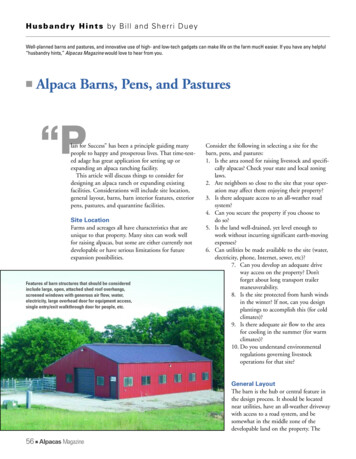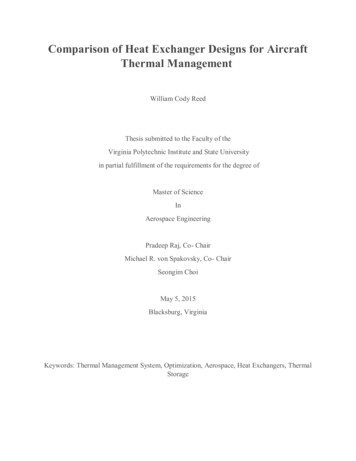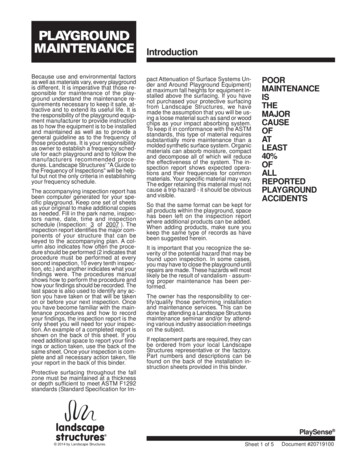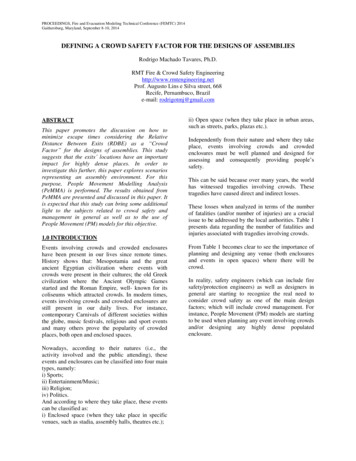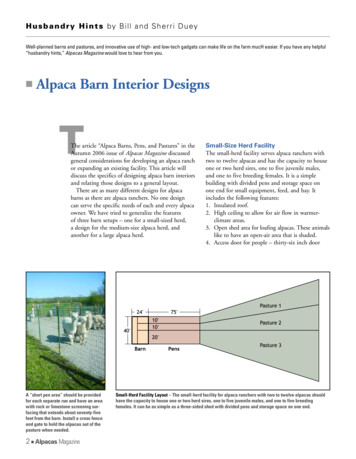
Transcription
H u s b a n d r y H i n t s by Bill and Sherri DueyWell-planned barns and pastures, and innovative use of high- and low-tech gadgets can make life on the farm mucH easier. If you have any helpful“husbandry hints,” Alpacas Magazine would love to hear from you. Alpaca Barn Interior DesignsTThe article “Alpaca Barns, Pens, and Pastures” in theAutumn 2006 issue of Alpacas Magazine discussedgeneral considerations for developing an alpaca ranchor expanding an existing facility. This article willdiscuss the specifics of designing alpaca barn interiorsand relating those designs to a general layout.There are as many different designs for alpacabarns as there are alpaca ranchers. No one designcan serve the specific needs of each and every alpacaowner. We have tried to generalize the featuresof three barn setups – one for a small-sized herd,a design for the medium-size alpaca herd, andanother for a large alpaca herd.A “short pen area” should be providedfor each separate run and have an areawith rock or limestone screening surfacing that extends about seventy-fivefeet from the barn. Install a cross fenceand gate to hold the alpacas out of thepasture when needed.2 Alpacas MagazineSmall-Size Herd FacilityThe small-herd facility serves alpaca ranchers withtwo to twelve alpacas and has the capacity to houseone or two herd sires, one to five juvenile males,and one to five breeding females. It is a simplebuilding with divided pens and storage space onone end for small equipment, feed, and hay. Itincludes the following features:1. Insulated roof.2. High ceiling to allow for air flow in warmerclimate areas.3. Open shed area for loafing alpacas. These animalslike to have an open-air area that is shaded.4. Access door for people – thirty-six inch doorSmall-Herd Facility Layout – The small-herd facility for alpaca ranchers with two to twelve alpacas shouldhave the capacity to house one or two herd sires, one to five juvenile males, and one to five breedingfemales. It can be as simple as a three-sided shed with divided pens and storage space on one end.
widths are best to allow for wheel barrows,carrying supplies, leading alpacas through, etc.5. Space allocated for the alpaca owners to handlealpacas out of the weather. Used for feedingand tending to the herd for everyday chores,monthly shots, weighing, and special care.6. Access for alpacas. Door openings should belarge enough to allow the alpacas easy accessinto the barn, yet allow for capability to close upthe barn (not required with open sided buildings, but nice to have that option.)7. Access for large farm equipment – overheaddoor clearance or open side access tall enough toallow motorized equipment such as a tractor orskid-steer to access the barn and loafing shedareas for maintenance and cleanup.8. Utilities – i.e., water and electricity.9. The open side of the barn should be positioneddown wind from prevailing winter winds.10.Doors, windows, or seasonal openings to allowfor adequate air flow in warm weather.11.Fencing and a gate at the drip line of the roofoverhang – this allows the alpaca owner to“lock” the alpacas under the roof in cases ofsevere weather.12.“Short pen area” – should be provided for eachseparate run and have an area with rock or limestone screening surfacing that extends aboutseventy-five feet from the barn. Install a crossfence and gate to hold the alpacas out of thepasture when needed.13.Interior fencing panels – these can be the traditional green steel alpaca panels, the newer pipeconduit panels, or custom-designed woodenboards attached to wood posts with woodscrews. Be sure to carefully include doors orgates at all of those points needed to movepeople or alpacas. Widths vary by manufacturer,so decide on a panel type to use and designyour pens accordingly. Custom panels can bemade to fit any space.(continued)Spring 2007 3
Husbandry HintsMedium-Size HerdFacility LayoutAn alpaca barn fora medium-size herdof twelve to twentyfour alpacas shouldhave a number of pensto separate herd sires,dams, dams withcrias, juvenile males,and others. The designshould provide all thefeatures for people,equipment storage,hay storage, shearingand marketing.A key consideration indesigning a mediumsized alpaca barn isto plan ahead. Try toincorporate thosethings you need forthe current sized herdand also include thoseitems that will allowyou to add more penswithout majorexpense at a latertime. This can be donerelatively easily.4 Alpacas Magazine
Medium-Size Herd FacilityAn alpaca barn for a medium-size herd of 12 to 24alpacas includes all of the basic elements mentionedabove. It is a much larger barn with potential forfuture expansion. It has larger pens for more herdsires, dams, and juvenile males. Most importantly, itis basically the large-size barn described below without the added features. The barn structure is similar,but has not been “finished out” with all the potential features incorporated. The medium-size barncan include any of the features of the large-size barnas you see a need and can work into your budget.Large-Size Herd FacilityFor herds from 24-40 alpacas, the large-size herdbarn is designed for efficiently handling a largenumber of alpacas for shots, toenail trimming,worming, veterinary procedures, etc. It also includesall of the basic elements mentioned for the smallsize barn, but includes an office/vet room, climatecontrolled stall, shearing area, breeding pen, etc.The design provides equipment storage and haystorage. Features include:1. The office/vet room – This room should have aninviting exterior door and attract visitors to enterthe barn at this point. Cabinets for storing supplies and equipment should be numerous. A tableand chairs, kitchen-height countertops for working standing up, and desk-height counters forconducting office functions should be included inthe design. A refrigerator/freezer for vet suppliesshould be included. Windows to the climatecontrolled stall, barn interior, and to the outsidewill all serve to allow you to work in the officeand still keep an eye on other alpaca activities.2. Restrooms – for you and your customers.3. Climate-controlled stall – this really comes inhandy. It is designed so you can see into it fromthe vet room. It efficiently uses the same utilityand heating and air conditioning systems. (SeeAlpacas Magazine, Winter 2005 issue, “AlpacaClimate-Controlled Alpaca Stall.”)Tom Martin andLew Corneliuscatch up on somerecord keepingin the office/veterinary roomat StarlightAlpaca Ranch.This roomincludes somedesk-heightcounters forconductingoffice-typefunctions.Spring 2007 5
Husbandry HintsOffice, Vet Room,Climate-ControlledStall UnitThis area is bestdesigned as afunctional unit.Heating and/orcooling and water,sewer, and electricityare all needed forthe three roomsof this zone.Large-Size HerdFacility LayoutThe interior of thebarn for a large-sizealpaca facility canalso include all ofthe ‘extras’ that youwant to incorporateinto the design.6 Alpacas Magazine
A large-size herdfacility layoutneeds to allowfor easy movement of alpacasfor handlingpurposes.4. Individual alpaca pens – for herd sires, finickyeaters, or separation for observations.5. Larger-group alpaca pens – group dams, damswith crias, and junior herd sires each in theirseparate larger group alpaca pens.6. Chute and scales – the chute is up near theoffice/vet room. It saves you steps and helpskeep your vet from having to walk all throughyour barn. All pens in the barn have connectivity to the chute/scale area by routing through aseries of gates, pens, and runs. By carefullydesigning connectivity into the setup, handlingalpacas can be done in a very efficient manner.(See Alpacas Magazine, Spring 2004 issue,“Chutes for Alpacas.”)7. Hay storage – large quantities of hay should notbe stored in main alpaca barns. Spontaneouscombustion from moisture in hay that is harvested with too high of a moisture content canstart a barn fire. Store dry, cured, hay in smallquantities in the alpaca barn.8. Feed storage – an area or room is set up to storebagged feed. It should be kept cool, dry, and freefrom rodent infestation.9. Fleece handling area – shearing is a huge eventand it deserves to have an efficient plan in place.The shearing area can be used as multiuse spaceat other times of the year, but at shearing time,it needs to be dedicated to the needs of shearingalpacas and handling fleece. The area is largeenough to allow for a shearing table or floor gymmats, a skirting table, another large table forhandling fleeces and space for people assistingthe shearer.Super-Size Herd FacilityFor herds larger than 40 alpacas, several factorsdrive rationale for breaking the large herd into separate units with separate barns, pens and pasturesthat serve specific functions. These separated barnsand pens should be connected with fenced runs foreasily moving those herds of alpacas to the centralfacility when needed. For instance, any combinationor all of these separate units could be considered: Junior herd sire barn, pens, and pastures Production females Herd sires Agisted alpacas Alpacas for saleThese separate units can each be designed similarto the small- or medium-size herd set-up, asdescribed earlier in this article, and then can beconnected to the “large central barn” by using longnarrow fenced runs. This way all alpacas can behandled in the central barn facility as needed.(Exception: quarantined alpacas.)The alpaca barn should be designed the way thatyou want it to function for your particular opera-Spring 2007 7
Husbandry HintsChute and scalesPosition thechute up nearthe office/vetroom. It willsave you andyour veterinarianlots of extrasteps. All pensin the barnshould haveconnectivity tothe chute/scalearea by routingthrough a seriesof pens or runs.By carefullydesigning thechute into thesetup, handlingalpacas can bedone in a veryefficient manner.tion. Try to incorporate all of those amenities thatyou need to start with and include consideration forthose that you want to add in the future. By building the barn building or shell as large as you canafford, you will be able to easily add features as yougrow your herd.Bill and Sherri Duey operate Southern Iowa Alpacas, located inthe hills of southern Iowa, 60 miles southeast of Des Moines.They specialize in raising Accoyo huacaya alpacas. They haveincorporated innovative features into their alpaca ranch andconduct seminars on business planning, animal selection, andranch setup for new alpaca ranchers. They also enjoy helpingexisting ranchers learn about new products and techniques forfine tuning their operation. You may view their website athttp://www.southerniowaalpacas.com or contact them directlyat alpacas@southerniowaalpacas.com.Duey’s original barn layout drawings converted to CADby Thomas Van Skike.Interior fencepanels can betraditional greenpanel, pipe conduit, or in thiscase, customizedwooden 2’ x 6”fence and gates.8 Alpacas Magazine
Alpaca Barn Interior Designs Well-planned barns and pastures, and innovative use of high- and low-tech gadgets can make life on the farm mucH easier. If you have any helpful “husbandry hints,” Alpacas Magazinewould love to hear from you. Small-Herd Facility Layout – The small-herd facility for alpaca ranchers with two to twelve alpacas shouldFile Size: 674KB
